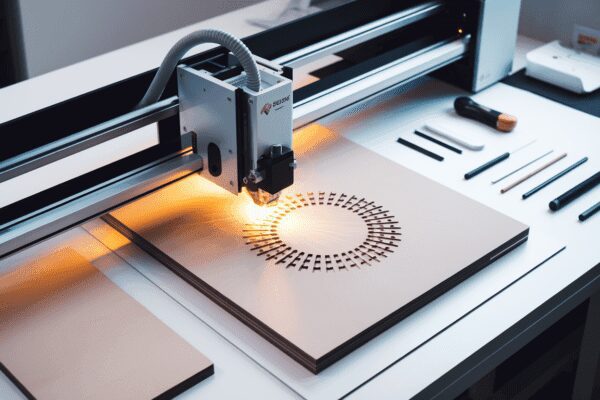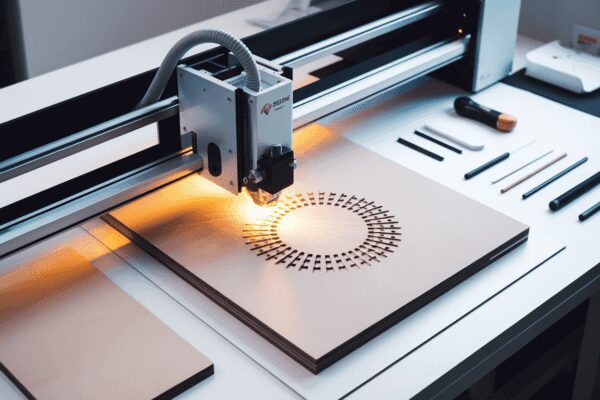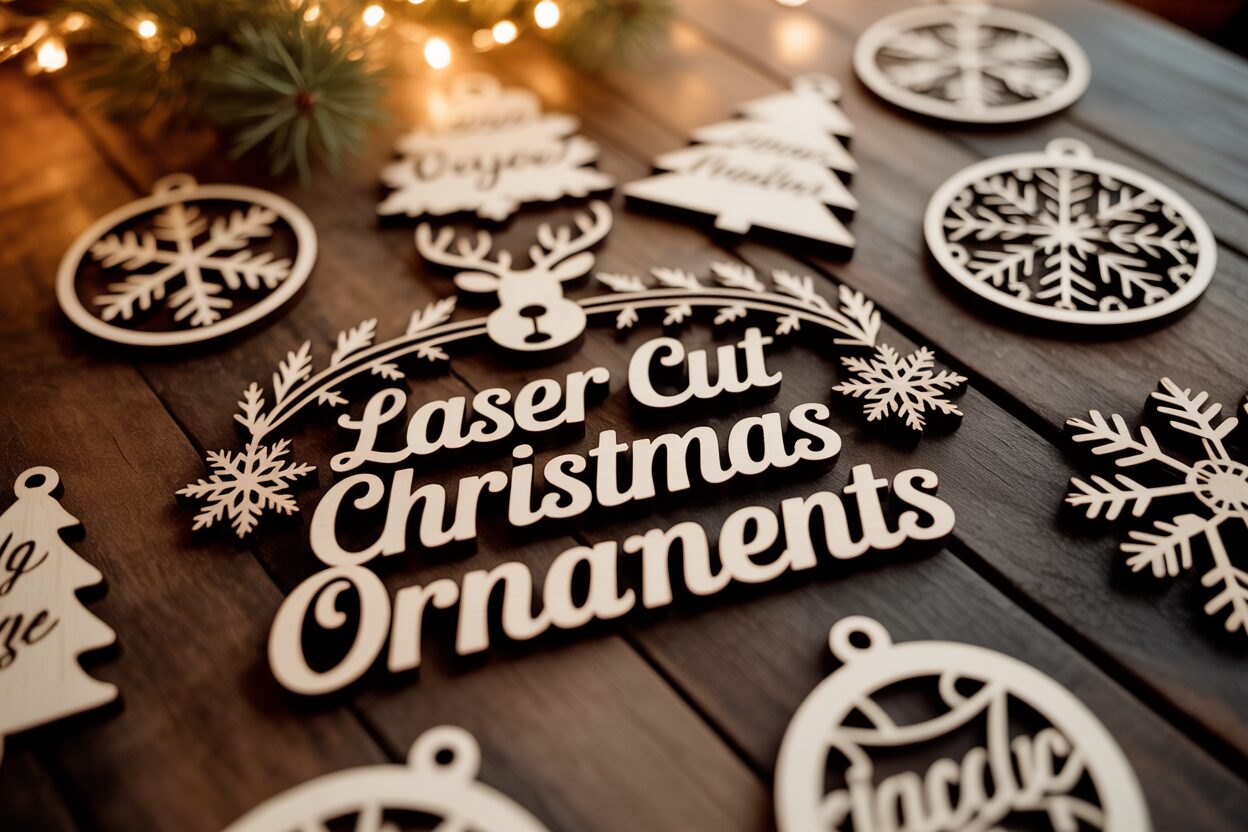Crafting Your Own Laser Cut Christmas Ornaments
Estimated reading time: 8 minutes
Key Takeaways
- Laser cutting allows for highly personalized, heirloom-quality Christmas ornaments by transforming simple materials like wood into intricate designs.
- Essential tools include a laser cutter (CO2 or Diode), vector design software (like Adobe Illustrator or the free Inkscape), and control software (like LightBurn).
- The best woods for ornaments, such as Baltic Birch Plywood, Cherry, and Maple, have fine, consistent grains that ensure clean cuts and detailed engravings.
- The process involves finding or creating a digital pattern, customizing it with text and details, properly calibrating laser settings (power, speed, focus), and executing the job safely.
- Proper preparation and finishing are key to a professional result; masking the wood prevents scorch marks, and finishing touches like sanding, painting, or sealing protect the ornament and enhance its appearance.
Table of Contents
- Getting Started with Laser Cut Ornaments
- Finding and Customizing Ornament Designs
- The Laser Cutting and Engraving Process
- Finishing and Assembling Your Ornaments
- Conclusions
- Frequently Asked Questions
Discover the magic of creating your own laser cut Christmas ornaments. This guide will teach you how to craft stunning, personalized decorations that will add a special touch to your holiday decor. Whether you’re a seasoned pro or just starting out, you’ll find everything you need to know to create beautiful, heirloom-quality ornaments that your family will cherish for years to come.
Getting Started with Laser Cut Ornaments
There’s a unique magic in unpacking Christmas decorations each year, especially those that hold a special meaning. While store-bought ornaments have their charm, creating your own DIY laser cut ornaments elevates this tradition to a new level. It’s about more than just making a decoration; it’s about crafting a memory, a tiny heirloom that captures a moment in time. The precision of a laser cutter allows you to transform a simple piece of wood into an intricate snowflake with your family’s name, a silhouette of your beloved pet, or a commemoration of a baby’s first Christmas. This level of personalization is what makes laser cut ornaments so special. They become conversation starters, cherished gifts, and beautiful, tangible reminders of what makes the holiday season truly yours. The process itself is incredibly rewarding, blending digital design with hands-on craftsmanship to produce stunning, professional-quality results right from your own workshop.
Essential Tools and Materials
Before you can bring your creative visions to life, you’ll need the right setup. The heart of your operation is, of course, the laser cutter. For home crafters, there are two primary types to consider. CO2 lasers, like the popular Glowforge, are powerful and versatile, capable of cutting and engraving a wide range of materials with speed and precision. They are often enclosed and feature user-friendly software, making them a great choice for beginners. On the other hand, diode lasers offer a more budget-friendly entry point into the hobby. While typically less powerful than CO2 lasers, they are more than capable of handling the thin wood used for ornaments. Your laser needs instructions, which come from design and control software. For creating your designs, vector graphics programs like Adobe Illustrator or the free alternative Inkscape are industry standards. To control the laser’s movements, power, and speed, software like LightBurn is highly regarded for its robust features and compatibility with many machines.
Choosing the Perfect Wood
The material you choose is just as important as the design. For laser cut wood ornaments, certain woods stand out for their workability and beautiful results.
- Baltic Birch Plywood: This is arguably the most popular choice, and for good reason. It’s affordable, stable, and has a light, uniform color that creates a high-contrast, easy-to-read engraving. Its smooth surface requires minimal sanding, making it perfect for intricate cuts and detailed designs.
- Cherry: For a warmer, richer look, cherry is an excellent choice. It has a beautiful reddish-brown hue that deepens with age and a fine, straight grain that engraves with stunning clarity. Ornaments made from cherry have a classic, premium feel.
- Maple: Known for its hardness and light, creamy color, maple is another fantastic option. Its very fine and dense grain provides a perfect canvas for incredibly detailed engravings, allowing for crisp lines and subtle shading. Maple’s durability also ensures your ornaments will last for generations.
These woods are ideal because their fine, consistent grain structure doesn’t interfere with the laser beam, preventing splintering and ensuring a clean, sharp cut and engraving. Having selected your tools and materials, the final piece of the puzzle is the design itself. A beautiful ornament begins with a well-crafted digital file, which is why finding or creating high-quality laser cut ornament patterns is the critical next step in our journey.
Finding and Customizing Ornament Designs
The journey to creating your personalized laser cut ornaments begins with a great design. Fortunately, the internet is overflowing with fantastic laser cut ornament patterns, catering to every style and skill level. For a vast selection of tested, high-quality designs, marketplaces like Etsy are invaluable. Here, you’ll find thousands of files from independent designers, often bundled into themed collections for a great value. Other sites like Creative Fabrica or Design Bundles also offer extensive libraries, many with commercial licenses included if you plan to sell your creations. If you’re looking for free options, many designers offer sample files on their blogs (including our own library of digital files!), and maker communities like the Glowforge Community Forum are a treasure trove of shared projects and free designs. When selecting a file, it’s crucial to know what to look for. A good design file will consist of clean vector lines with no breaks or overlapping paths. The elements intended for cutting should be thick enough to be durable; extremely thin swirls or text are fragile and can easily snap. Ideally, the design will have a designated blank space, like a banner or a clear central area, specifically intended for personalization.
From Pattern to Personal Treasure
Once you’ve chosen a base pattern, the real magic begins: customization. This is how you transform a beautiful but generic design into a one-of-a-kind keepsake. Let’s walk through the process of adding a name and year to a snowflake ornament using a vector design program like Adobe Illustrator or Inkscape.
- Import and Prepare: Open your chosen ornament file. Ungroup the elements so you can work with them individually. Identify the area where you want to add your text.
- Add Your Text: Select the Text Tool and type your desired name or message, like “The Millers” and “2023”. Don’t worry about placement just yet; we’ll refine that in a moment.
- Font Selection is Key: The font you choose dramatically affects the final look. For a classic, elegant feel, a script font like “Great Vibes” or “Amarillo” works beautifully. Important: If you use a script font where letters overlap, you must weld (or “unite”) the letters together. This turns the text into a single, continuous shape, ensuring it cuts out as one piece rather than individual, disconnected letters. For smaller text, like a year, a clean and simple sans-serif font like “Montserrat” or a clear serif font like “Georgia” ensures legibility.
- Placement and Sizing: Move your text into the desired position on the ornament. Use your software’s alignment tools to perfectly center it within a banner or the ornament’s frame. Resize the text so it’s large enough to be easily read but doesn’t overpower the rest of the design.
- Convert to Paths: This is the final, critical step. Select your text and convert it to paths (sometimes called “Create Outlines”). This changes the editable text into a vector shape that the laser software can understand as a cutting or engraving instruction.
By following these steps, you can confidently customize any base pattern, ensuring your finished pieces are truly personalized laser cut ornaments that will be treasured for years to come.
The Laser Cutting and Engraving Process
With your digital design perfected, it’s time to move to the laser cutter and bring your creations into the physical world. Proper preparation of your material is the first step to achieving a professional finish. While many woods suitable for ornaments are pre-sanded, a quick pass with a fine-grit sandpaper (220-grit or higher) can remove any minor blemishes and ensure the surface is perfectly smooth for engraving. The most crucial preparation step, however, is masking. Laser cutting wood can sometimes leave small scorch marks or a smoky haze around the cut lines, a phenomenon known as “flashback.” To prevent this, cover the entire surface of your wood with a low-tack paper masking tape or transfer paper. This protective layer will absorb the scorching, and after the job is complete, you can simply peel it away to reveal a pristine, clean surface underneath. This simple step makes a dramatic difference in the final quality of your laser cut Christmas ornaments.
Calibrating Your Laser for Perfect Cuts
Before you can press ‘start’, you must tell the laser exactly how to interact with the wood. This is done through three primary settings: power, speed, and focus.
- Power: This determines the intensity of the laser beam. For cutting through 1/8″ birch plywood, you’ll typically use 80-100% power. For engraving, a much lower power setting is needed, as you only want to mark the surface, not cut through it.
- Speed: This is how fast the laser head moves. Cutting requires a slower speed to allow the beam enough time to burn through the material. Engraving, on the other hand, is done at a much higher speed. A good starting point for a balanced engraving is often a high speed with moderate power.
- Focus: The laser beam must be precisely focused on the surface of the material for the cleanest cut. Most modern lasers have an auto-focus feature, but it’s essential to ensure it has been run correctly for your material’s specific thickness.
These settings work together and will vary for every machine and material type. It is always a best practice to run a small test cut on a scrap piece of the same wood before running your full batch of ornaments. This allows you to dial in the perfect settings without wasting your primary material.
Executing the Job and Troubleshooting
With your wood masked and your settings tested, place the material flat on the laser bed, securing it with honeycomb pins if necessary to prevent it from shifting. Load your design file into your laser software and use the camera overlay or framing function to position your ornament designs efficiently on the wood, minimizing waste. Double-check that your cut lines are set to “Cut” and your engraving elements are set to “Engrave.” Now, for the most important step: safety. Ensure your laser’s ventilation system is running correctly to exhaust all fumes. Put on your certified laser safety glasses. Once you begin the job, never leave the laser cutter unattended. Stay present to monitor for any flare-ups or issues. If you notice your cuts aren’t going all the way through, the most likely culprits are incorrect speed/power settings, a dirty lens, or improper focus. Pause the job, check these elements, and adjust as needed. If your engraving appears uneven, ensure your wood is perfectly flat, as even a slight warp can affect focus and engraving depth. By being attentive, you can solve most common issues on the fly and ensure every batch of laser cut Christmas ornaments comes out flawlessly.
Finishing and Assembling Your Ornaments
Once the hum of the laser fades, you’re left with a sheet of beautifully cut wooden pieces. This is where the final transformation from a simple cutout to a cherished ornament takes place. The first step is cleanup. Carefully peel away the protective masking tape you applied earlier. This reveal is one of the most satisfying parts of the process, exposing the clean, scorch-free surface of your ornament. Even with masking, you may find a tiny bit of smoke residue on the edges. A soft cloth lightly dampened with isopropyl alcohol or a simple baby wipe will gently clean this away without damaging the wood. For an ultra-smooth, professional feel, take a moment to lightly sand the front, back, and edges with a high-grit sandpaper (320-grit or higher) or a sanding block. This removes any minor roughness and prepares the surface perfectly for any finishes you plan to apply to your laser cut wood ornaments.
Adding Color and Protection
Leaving the wood in its natural state is a beautiful, rustic option, but adding a finish can protect the ornament and help it match your holiday decor. The possibilities are endless.
- Painting: Acrylic craft paints are perfect for adding pops of color. You can paint the entire ornament or use fine-tipped paint pens or small brushes to color in specific engraved areas, like a name or a design element. For a touch of festive sparkle, consider a metallic gold or silver paint.
- Staining: If you want to enhance the natural grain of the wood, a wood stain is an excellent choice. Apply a small amount with a cloth, let it penetrate for a few minutes, and then wipe off the excess. This can give a rich, deep color to cherry or a warm, golden hue to birch.
- Sealing: This is a crucial final step to protect your work. A clear spray sealant (like polyurethane or acrylic lacquer) is the easiest way to apply an even coat over intricate designs. It will protect the wood from moisture and handling, ensuring your ornament lasts for years. Sealants are available in various sheens, from a non-reflective matte to a subtle satin or a shiny gloss finish.
Final Assembly and Embellishments
The very last step is adding the hanger and any extra decorative touches that will elevate your laser cut ornaments. A simple hole is already part of most designs, making this part easy and fun. You can thread a beautiful ribbon, some rustic twine, or a simple metallic cord through the hole for hanging. Don’t be afraid to add more flair. A tiny dab of wood glue can secure a small jingle bell to the bottom of an ornament, add a colorful bead to the hanging loop, or even attach a small bow to the front. These small details are what make each piece truly unique. As you tie the final ribbon, you’re not just completing a craft project; you’re holding a finished memory. The joy of creating these personalized laser cut ornaments is matched only by the delight of hanging them on the tree or gifting them to loved ones, sharing a piece of your creativity and heart during the holiday season.
Conclusions
Now you have the knowledge and skills to create your own beautiful laser cut Christmas ornaments. With a little practice, you’ll be able to design and create unique, personalized decorations that will be the envy of all your friends and family. Don’t be afraid to experiment with different designs, materials, and finishing techniques to create one-of-a-kind ornaments that reflect your personal style.
Frequently Asked Questions
Q: What’s the best wood for a beginner making laser cut ornaments?
A: Baltic Birch plywood is the most recommended choice for beginners. It’s affordable, stable, has a light color that provides excellent contrast for engraving, and its smooth surface requires minimal sanding.Interested in more Ornaments? Check out our Ornaments laser file designs: Click here!
Q: Do I need expensive software to design my ornaments?
A: No. While professional software like Adobe Illustrator is an industry standard, free alternatives like Inkscape are powerful enough to create and customize high-quality vector designs suitable for any laser cutter.
Q: How do I prevent burn marks on my wooden ornaments?
A: The best way to prevent scorch marks or “flashback” is to apply a low-tack paper masking tape to the entire surface of the wood before cutting. After the laser job is complete, you simply peel the tape off to reveal a clean, pristine surface underneath.


Subscribe to Our Newsletter
And enjoy FREE Download Files, SALE Alerts and Inspiring TIPS


A Comprehensive Guide to Crafting Engraved Slate Coasters
A Comprehensive Guide to Laser Engraving Slate Coasters
A Guide to Crafting a Personalized Charcuterie Board
Valentine Love Captions: 6 Charcuterie Board Engraving Files…
$8.00Original price was: $8.00.$5.60Current price is: $5.60.(30% off)
Bee and Honey Jar Charcuterie Board Engraving File | PNG Download #007…
$4.00Original price was: $4.00.$3.20Current price is: $3.20.(20% off)
Charcuterie Board Engraving File – Wine & Grapes 3D Illusion…
$4.00Original price was: $4.00.$3.00Current price is: $3.00.(25% off)
American Eagle Flag Laser Engraving File for Charcuterie & Cutting…
$4.00Original price was: $4.00.$2.80Current price is: $2.80.(30% off)